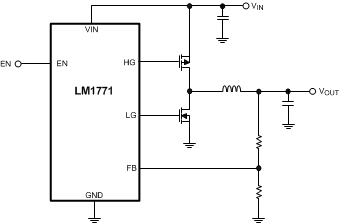SNVS446D June 2006 – January 2016 LM1771
PRODUCTION DATA.
- 1 Features
- 2 Applications
- 3 Description
- 4 Revision History
- 5 Pin Configuration and Functions
- 6 Specifications
- 7 Detailed Description
-
8 Application and Implementation
- 8.1 Application Information
- 8.2 Typical Applications
- 9 Power Supply Recommendations
- 10Layout
- 11Device and Documentation Support
- 12Mechanical, Packaging, and Orderable Information
1 Features
2 Applications
- Simple-to-Design, High-Efficiency, Step-Down Switching Regulators
- FPGAs, DSPs, and ASIC Power Supplies
- Set-Top Boxes
- Cable Modems
- Printers
- Digital Video Recorders
- Servers
- Graphic Cards
3 Description
The LM1771 device is an efficient synchronous buck switching controller with a precision enable requiring no external compensation. The constant ON-time control scheme provides a simple design free of compensation components, allowing minimal component count and board space. The precision enable pin allows flexibility in sequencing multiple rails and setting UVLO. The LM1771 also incorporates a unique input feedforward to maintain a constant frequency independent of the input voltage. The LM1771 is optimized for a low-voltage input range of 2.8 V to 5.5 V and can provide an adjustable output as low as 0.8 V. Driving an external high-side PFET and low-side NFET, it can provide efficiencies as high as 95%.
Three versions of the LM1771 are available depending on the switching frequency desired for the application. Nominal switching frequencies are in the range of 100 kHz to 1000 kHz.
Device Information(1)
| PART NUMBER | PACKAGE | BODY SIZE (NOM) |
|---|---|---|
| LM1771 | WSON (6) | 3.00 mm × 3.00 mm |
| VSSOP (8) | 3.00 mm × 3.00 mm |
- For all available packages, see the orderable addendum at the end of the data sheet.
Typical Application Circuit
